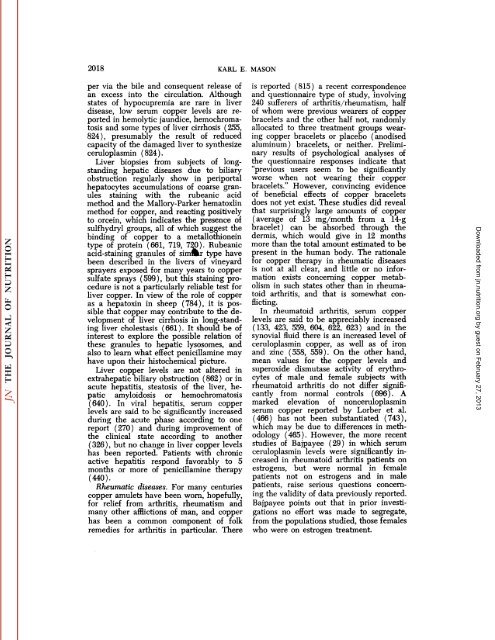conspectus of researchon copper metabolism and requirements
conspectus of researchon copper metabolism and requirements
conspectus of researchon copper metabolism and requirements
Create successful ePaper yourself
Turn your PDF publications into a flip-book with our unique Google optimized e-Paper software.
2018 KARL E. MASON<br />
per via thèbile <strong>and</strong> consequent release <strong>of</strong><br />
an excess into the circulation. Although<br />
states <strong>of</strong> hypocupremia are rare in liver<br />
disease, low serum <strong>copper</strong> levels are re<br />
ported in hemolytic jaundice, hemochromatosis<br />
<strong>and</strong> some types <strong>of</strong> liver cirrhosis (255,<br />
824), presumably the result <strong>of</strong> reduced<br />
capacity <strong>of</strong> the damaged liver to synthesize<br />
ceruloplasmin (824).<br />
Liver biopsies from subjects <strong>of</strong> long<br />
st<strong>and</strong>ing hepatic diseases due to biliary<br />
obstruction regularly show in periportal<br />
hepatocytes accumulations <strong>of</strong> coarse gran<br />
ules staining with the rubeanic acid<br />
method <strong>and</strong> the Mallory-Parker hematoxlin<br />
method for <strong>copper</strong>, <strong>and</strong> reacting positively<br />
to orcein, which indicates the presence <strong>of</strong><br />
sulfhydryl groups, all <strong>of</strong> which suggest the<br />
binding <strong>of</strong> <strong>copper</strong> to a metallothionein<br />
type <strong>of</strong> protein (661, 719, 720). Rubeanic<br />
acid-staining granules <strong>of</strong> similar type have<br />
been described in the livers <strong>of</strong> vineyard<br />
sprayers exposed for many years to <strong>copper</strong><br />
sulfate sprays (599), but this staining pro<br />
cedure is not a particularly reliable test for<br />
liver <strong>copper</strong>. In view <strong>of</strong> the role <strong>of</strong> <strong>copper</strong><br />
as a hepatoxin in sheep (784), it is pos<br />
sible that <strong>copper</strong> may contribute to the de<br />
velopment <strong>of</strong> liver cirrhosis in long-st<strong>and</strong><br />
ing liver cholestasis (661). It should be <strong>of</strong><br />
interest to explore the possible relation <strong>of</strong><br />
these granules to hepatic lysosomes, <strong>and</strong><br />
also to learn what effect penicillamine may<br />
have upon their histochemical picture.<br />
Liver <strong>copper</strong> levels are not altered in<br />
extrahepatic biliary obstruction (862) or in<br />
acute hepatitis, steatosis <strong>of</strong> the liver, he<br />
patic amyloidosis or hemochromatosis<br />
(640). In viral hepatitis, serum <strong>copper</strong><br />
levels are said to be significantly increased<br />
during the acute phase according to one<br />
report (270) <strong>and</strong> during improvement <strong>of</strong><br />
the clinical state according to another<br />
(326 ), but no change in liver <strong>copper</strong> levels<br />
has been reported. Patients with chronic<br />
active hepatitis respond favorably to 5<br />
months or more <strong>of</strong> penicillamine therapy<br />
(440).<br />
Rheumatic diseases. For many centuries<br />
<strong>copper</strong> amulets have been worn, hopefully,<br />
for relief from arthritis, rheumatism <strong>and</strong><br />
many other afflictions <strong>of</strong> man, <strong>and</strong> <strong>copper</strong><br />
has been a common component <strong>of</strong> folk<br />
remedies for arthritis in particular. There<br />
is reported (815) a recent correspondence<br />
<strong>and</strong> questionnaire type <strong>of</strong> study, involving<br />
240 sufferers <strong>of</strong> arthritis/rheumatism, half<br />
<strong>of</strong> whom were previous wearers <strong>of</strong> <strong>copper</strong><br />
bracelets <strong>and</strong> the other half not, r<strong>and</strong>omly<br />
allocated to three treatment groups wear<br />
ing <strong>copper</strong> bracelets or placebo (anodised<br />
aluminum) bracelets, or neither. Prelimi<br />
nary results <strong>of</strong> psychological analyses <strong>of</strong><br />
the questionnaire responses indicate that<br />
"previous users seem to be significantly<br />
worse when not wearing their <strong>copper</strong><br />
bracelets." However, convincing evidence<br />
<strong>of</strong> beneficial effects <strong>of</strong> <strong>copper</strong> bracelets<br />
does not yet exist. These studies did reveal<br />
that surprisingly large amounts <strong>of</strong> <strong>copper</strong><br />
(average <strong>of</strong> 13 mg/month from a 14-g<br />
bracelet) can be absorbed through the<br />
dermis, which would give in 12 months<br />
more than the total amount estimated to be<br />
present in the human body. The rationale<br />
for <strong>copper</strong> therapy in rheumatic diseases<br />
is not at all clear, <strong>and</strong> little or no infor<br />
mation exists concerning <strong>copper</strong> metab<br />
olism in such states other than in rheuma<br />
toid arthritis, <strong>and</strong> that is somewhat con<br />
flicting.<br />
In rheumatoid arthritis, serum <strong>copper</strong><br />
levels are said to be appreciably increased<br />
(133, 423, 559, 604, 622, 623) <strong>and</strong> in the<br />
synovial fluid there is an increased level <strong>of</strong><br />
ceruloplasmin <strong>copper</strong>, as well as <strong>of</strong> iron<br />
<strong>and</strong> zinc (558, 559). On the other h<strong>and</strong>,<br />
mean values for the <strong>copper</strong> levels <strong>and</strong><br />
Superoxide dismutase activity <strong>of</strong> erythrocytes<br />
<strong>of</strong> male <strong>and</strong> female subjects with<br />
rheumatoid arthritis do not differ signifi<br />
cantly from normal controls (696). A<br />
marked elevation <strong>of</strong> nonceruloplasmin<br />
serum <strong>copper</strong> reported by Lorber et al.<br />
(466) has not been substantiated (743),<br />
which may be due to differences in meth<br />
odology (465). However, the more recent<br />
studies <strong>of</strong> Bajpayee (29) in which serum<br />
ceruloplasmin levels were significantly in<br />
creased in rheumatoid arthritis patients on<br />
estrogens, but were normal in female<br />
patients not on estrogens <strong>and</strong> in male<br />
patients, raise serious questions concern<br />
ing the validity <strong>of</strong> data previously reported.<br />
Bajpayee points out that in prior investi<br />
gations no effort was made to segregate,<br />
from the populations studied, those females<br />
who were on estrogen treatment.<br />
Downloaded from<br />
jn.nutrition.org<br />
by guest on February 27, 2013
















